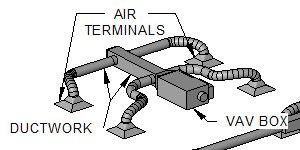 | ||
Variable Air Volume (VAV) is a type of heating, ventilating, and/or air-conditioning (HVAC) system. Unlike constant air volume (CAV) systems, which supply a constant airflow at a variable temperature, VAV systems vary the airflow at a constant temperature. The advantages of VAV systems over constant-volume systems include more precise temperature control, reduced compressor wear, lower energy consumption by system fans, less fan noise, and additional passive dehumidification.
Contents
Simple VAV systems(VAV)
The simplest VAV system incorporates one supply duct that, when in cooling mode, distributes supply air at a constant temperature of approximately 55 °F (13 °C). Because the supply air temperature is constant, the air flow rate must vary to meet the rising and falling heat gains or losses within the thermal zone served.
Even a simple VAV system has several advantages over a CAV system. One is more precise temperature control. To meet a space cooling load, a CAV unit operates the fan and compressor at full capacity until the temperature drops to a specified limit, and then the compressor turns off. This on/off cycling causes the temperature to fluctuate above and below the temperature setpoint. In a single-zone VAV unit, the fan speed varies depending on the actual space temperature and the temperature setpoint, while the compressor modulates the refrigerant flow to maintain a constant supply air temperature. The result is more precise space temperature control.
Another advantage is energy savings and reduced wear. VAV fan control, especially with modern electronic variable-speed drives, reduces the energy consumed by fans, which can be a substantial part of the total cooling energy requirements of a building. Modulating control of the compressor also reduces wear and delivers further energy savings.
A final advantage is increased dehumidification. Because VAV air flow is reduced under part-load conditions, air is exposed to cooling coils for a longer time. More moisture condenses on the coils, dehumidifying the air. Thus, although a constant-volume and a single-zone VAV unit maintain the same room temperature, the VAV unit provides more passive dehumidification and more comfortable space conditions.
Multiple-zone VAV systems
The air blower's flow rate is variable. For a single VAV air handler that serves multiple thermal zones, the flow rate to each zone must be varied as well.
A VAV terminal unit, often called a VAV box, is the zone-level flow control device. It is basically a calibrated air damper with an automatic actuator. The VAV terminal unit is connected to either a local or a central control system. Historically, pneumatic control was commonplace, but electronic direct digital control systems are popular especially for mid- to large-size applications. Hybrid control, for example having pneumatic actuators with digital data collection, is popular as well.
A common commercial application is shown in the diagram. This VAV system consists of a VAV box, ductwork, and four air terminals.
Fan control
Control of the system's fan capacity is critical in VAV systems. Without proper and rapid flow rate control, the system's ductwork, or its sealing, can easily be damaged by overpressurization. In the cooling mode of operation, as the temperature in the space is satisfied, a VAV box closes to limit the flow of cool air into the space. As the temperature increases in the space, the box opens to bring the temperature back down. The fan maintains a constant static pressure in the discharge duct regardless of the position of the VAV box. Therefore, as the boxes closes, the fan slows down or restricts the amount of air going into the supply duct. As the boxes open, the fan speeds up and allows more air flow into the duct, maintaining a constant static pressure.
One of the challenges for VAV systems is providing adequate temperature control for multiple zones with different environmental conditions, such as an office on the glass perimeter of a building vs. an interior office down the hall. Dual duct systems provide cool air in one duct and warm air in a second duct to provide an appropriate temperature of mixed supply air for any zone. An extra duct, however, is cumbersome and expensive. Reheating the air from a single duct, using electric or hot water heating, is often a more cost-effective solution.
